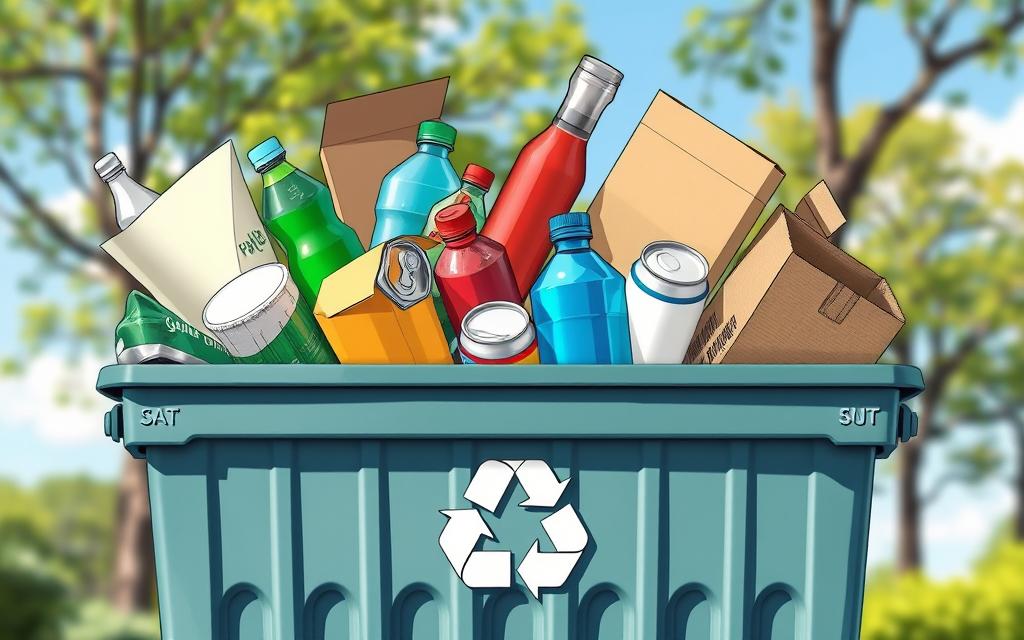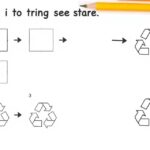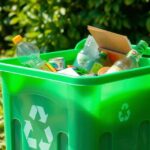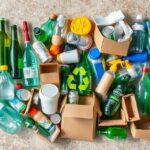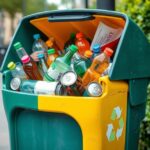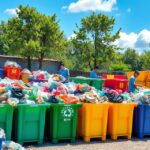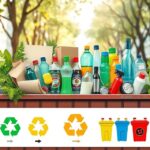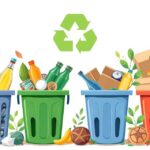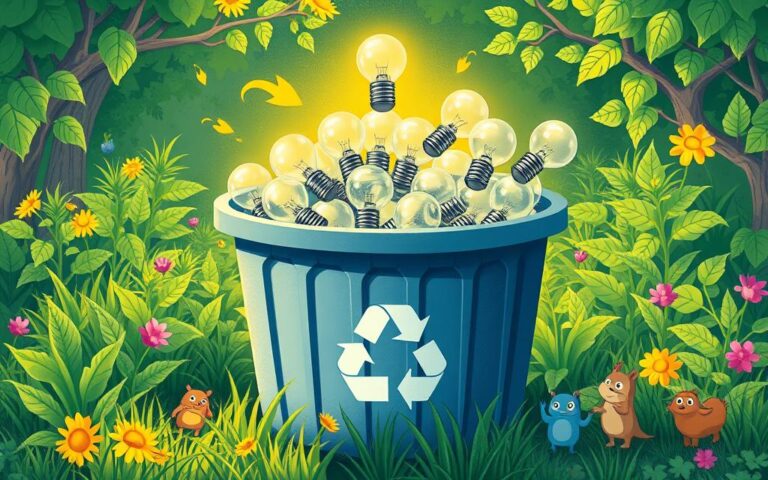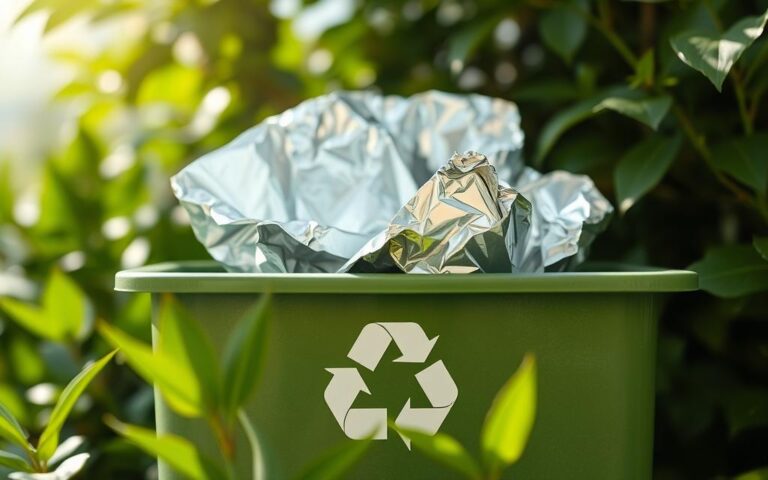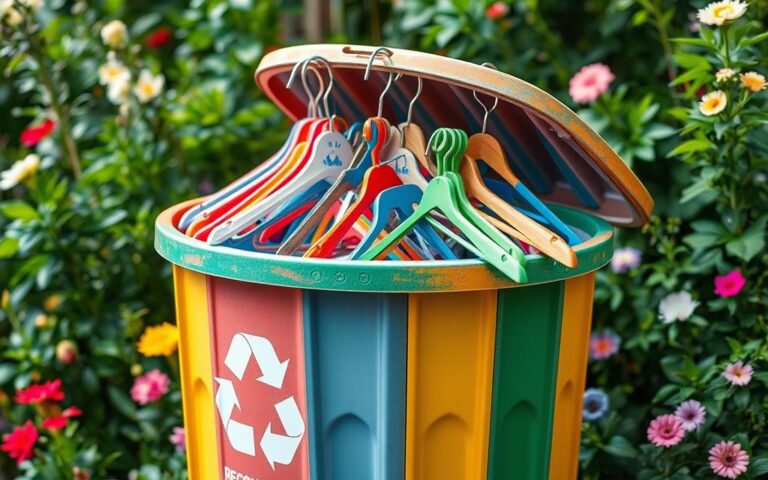What Can Go in the Recycling Bin? Guidelines for Sorting
Recycling plays a huge part in keeping our planet clean. Knowing the recycling guidelines helps us sort waste properly. Yet, what you can recycle often depends on where you live. For instance, in Portland, whether plastic can be recycled depends on its size and shape, not just the recycle symbol.
Keeping non-recyclables out of recycling bins is crucial. For recycling to work, items need to be clean, dry, and empty. If you’re unsure if something can be recycled, it’s best to check with your local rules. This way, you help make recycling effective.
Introduction to Recycling
Recycling helps us turn old materials into new treasures. It’s a big part of waste management today. By recycling things like paper, metal, glass, and plastic, we contribute to a greener planet. This process helps save our natural resources and makes the future sustainable.
To make recycling work, everyone needs to learn how it’s done. Dirty items can ruin a whole truckload of recycling. That’s why it’s key to keep recyclables clean and dry. By knowing how to sort things correctly, we all help make recycling successful.
Knowing what can and cannot be recycled makes the system work better. Things like newspapers and glass jars are usually okay, but plastic bags and Styrofoam aren’t. Understanding this helps our environment both locally and globally.
When we all recycle the right way, we support a circular economy. This means materials get reused, not wasted. And by learning about recycling, such as through educational initiatives, we promote sustainable living. It’s about being mindful of our planet’s future.
| Recyclable Items | Non-Recyclable Items |
|---|---|
| Paper (newspapers, magazines) | Greasy paper (pizza boxes) |
| Cardboard (OCC) | Used paper towels and tissues |
| Glass bottles and jars | Styrofoam (expanded polystyrene) |
| Rigid plastics | Electronics (e-waste) |
| Metal containers (tin, aluminium) | Construction debris (cement, drywall) |
Why is Recycling Important?
Recycling is key for a green future. It cuts waste in landfills and lowers harmful gases like methane. Landfills cause lots of pollution. To help our planet, it’s vital we reduce what we dump in them.
Recycling helps save our natural world. Almost all resources we use can’t be replaced. Recycling things like aluminium saves lots of energy. It needs 95% less energy than making new from raw materials. This helps us use less of the Earth’s resources.
It also makes jobs. In the USA, recycling has made over a million jobs. In Massachusetts alone, recycling supports over 9,000 jobs, boosting the state’s economy.
Recycling uses less resources. For example, recycling paper means we need less wood. Without recycling, we would have needed 80% more wood for paper by 2010. With recycling, we reduced this need by 60%.
Recycling faces challenges, especially with different materials. But, if done right, 90% of recyclable items can help the environment. We need smart ways to recycle more effectively.
What Can Go in the Recycling Bin?
It’s key to know what goes in the recycling bin for smart waste management. Proper sorting helps keep valuable materials for future use, aiding sustainability. It’s important for people to learn which items their local programmes take. This includes recyclable materials like metals, glass, paper, and some plastics.
Common Acceptable Items
Many items are okay for recycling bins and are crucial for the process. These items must be clean and free from food to avoid ruining the batch.
- Aluminium cans
- Glass bottles
- Clean plastic bottles
- Metal caps and lids
- Beverage cartons like juice boxes
Paper and Cardboard Recycling
Clean and dry paper products are good for paper recycling. You can recycle things like flat cardboard boxes, paper bags, and newspapers if they’re clean. For example, pizza box tops are okay if they’re not greasy. Any greasy parts must be thrown away, though.
Plastics You Can Recycle
Understanding which plastics are okay is crucial. Hard plastic containers, including those for water, soda, and detergents, are often recyclable. They should have resin codes #1, #2, #4, or #5. Make sure to rinse them and keep caps on, unless it’s a spray nozzle or pump. Avoid recycling soft plastics like bags and wrappers.
| Item Type | Recyclable | Notes |
|---|---|---|
| Aluminium cans | Yes | Rinse before disposal |
| Glass bottles | Yes | Clear, green, and brown bottles accepted |
| Plastic bottles | Yes | Check resin codes |
| Cardboard boxes | Yes | Flattened and dry |
| Beverage cartons | Yes | Remove plastic film when possible |
| Plastic bags | No | Dispose of in landfill |
Following these rules makes recycling more effective and leads to a greener future. Using recyclable materials again saves resources. It also cuts down on pollution and landfill usage.
Items That Cannot be Recycled Curbside
It’s crucial to know what cannot go in your recycling bin. Many people think lots of items can be recycled. But, sadly, many items should not end up in the blue recycle cart. Here, we’ll talk about the key non-recyclable items and give tips on what items to avoid in the recycling bin.
Plastics and Food Containers
Keep many plastic items out of curbside recycling. These include:
- Plastic bags and plastic wrap, which can damage recycling machinery.
- Clamshell containers, often not accepted due to their lightweight nature.
- Plastic utensils and straws that contain plastic #6 (polystyrene), seldom recycled.
Food containers with food waste must also stay out. Only clean, dry containers can be recycled. So, grease or residue means they go in the trash, not recycling.
Other Non-Recyclable Materials
There are several other materials you should not recycle. These include:
- Aerosol cans, even if metal, are not for recycling bins and can harm the recycling process.
- Electronics like old TVs and small appliances don’t go curbside.
- Household Hazardous Waste, including old medicines, needs safe disposal.
- Styrofoam and polystyrene items, such as egg cartons and coffee cups, can’t break down in landfills and are not recyclable.
- Food waste should be composted instead.
- Mattresses, harmful to the environment in landfills, can be recycled or donated.
Knowing and following curbside recycling restrictions helps keep recycling clean. It makes recycling more effective, too.
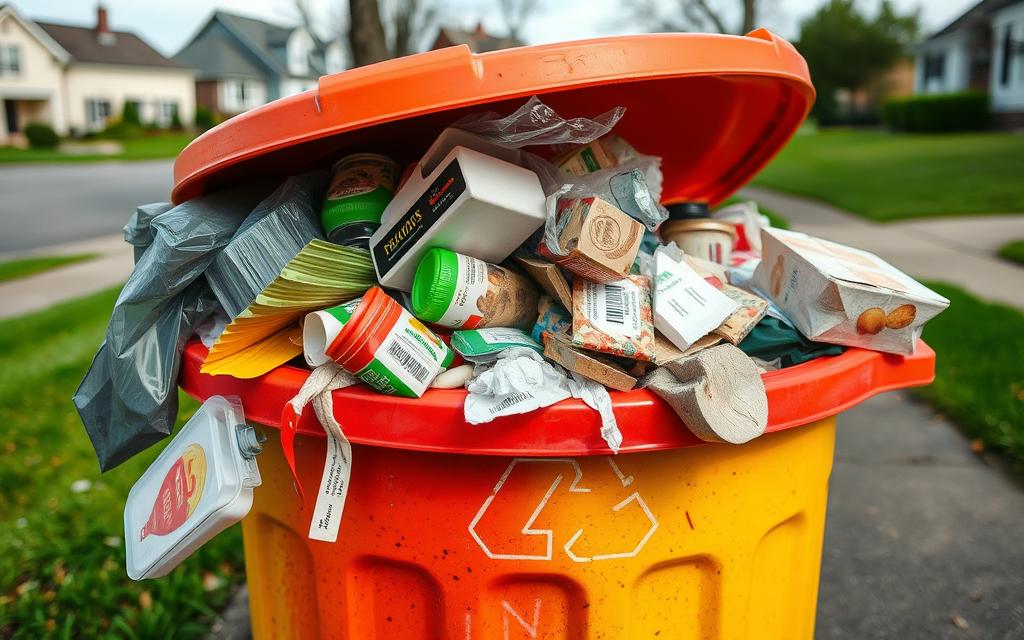
Tips for Effective Recycling
To recycle well, you need to know and be careful. Start by learning your local recycling rules. These rules tell you what materials you can recycle. Knowing these recycling tips makes your recycling efforts better.
Cleaning your recyclables helps a lot. In the U.S., about 25% of recycling gets dirty from food. Make sure everything is clean of food and liquid. This keeps the recycling process working well.
Having a guide of what you can recycle helps. Put it where you recycle. It reminds you how to sort your waste right. Usually, plastics marked with numbers 1 and 2 are recyclable. Plastics with higher numbers are harder to recycle.
If you’re not sure if something can be recycled, it’s better to throw it away. This stops you from wishcycling. Wishcycling is when you hope something is recyclable but it’s not. This can mess up the whole recycling batch.
Follow the recycling best practices to avoid common mistakes. Don’t recycle plastic bags, some food containers, and compostable plastics. Doing this right helps you and everyone’s recycling efforts.
| Item Type | Recyclable | Comments |
|---|---|---|
| Plastic bottles and jugs | Yes | Labels #1 and #2 are easily recycled. |
| Plastic bags | No | Major contaminant; must be disposed of properly. |
| Food containers | Depends | Must be clean and empty; otherwise, they contaminate the load. |
| Compostable plastics | No | Must be disposed of in compost bins or trash. |
| Glass items | Depends | Check local regulations. |
By taking these steps, you’re not just recycling—you’re recycling the right way. These tips help you keep our planet clean and future sustainable.
Understanding Local Recycling Guidelines
Every community has its own recycling rules. These rules tell us which materials can be recycled and how to prepare them. It’s important to know these guidelines to recycle effectively. Checking resources from local waste management can help follow the rules better. This ensures high recycling rates.
Learning about recycling is key to understanding what materials are accepted. With better knowledge, people can join in community recycling initiatives more effectively. Knowing what can and cannot be recycled helps cut down on wrong items being recycled. This supports sustainability.
The following table shows common recyclable materials and how they should be prepared:
| Material Type | Common Examples | Preparation Requirements |
|---|---|---|
| Plastics | Plastic bottles and jars #1 to #7, including soft drink bottles, milk jugs | All items must be cleaned |
| Metals | Aluminium cans, tin cans, steel food containers | CLEAN OF FOOD; lids must be removed |
| Cardboard | Corrugated cardboard, shipping boxes, cereal boxes | MUST BE FLATTENED |
| Paper | Newspapers, magazines, notebook paper | No special preparation needed |
| Glass | Glass bottles and jars | CLEANED; lids must be removed |
Following local recycling guidelines helps us all. By joining community efforts, we make the environment cleaner. Every small step towards recycling right counts. It leads to a community that is well-informed and cares about recycling.
How to Reduce Recycling Contamination
Keeping recycling clean is key to successful recycling. Knowing what not to throw in the bin helps. Different places have their own rules on what’s recyclable. It’s important for everyone to follow their local guidelines to recycle right.
Some things mess up the recycling process, like plastic bags, straws, and coffee lids. These not only make sorting harder but can spoil the whole recycling batch. Even clean recyclables, if greasy or dirty, cause problems. Wrong items in the recycling bin might mean good stuff goes to waste, ending up in landfill.
Just one person’s mistake can affect the whole system. This risks the effort of those who recycle carefully. Teaching people what goes in the bin and labeling bins clearly can help. This can make a big difference in cutting down wrong items in recycling and build a recycling culture.
The following table highlights the common contaminants and their impact on recycling processes:
| Contaminant | Impact on Recycling | Recommended Action |
|---|---|---|
| Plastic Bags | Clogging sorting machinery | Use reusable bags |
| Food Residue | Rendering recyclables non-viable | Rinse items before disposal |
| Straws and Coffee Lids | Increasing landfill waste | Avoid single-use items |
| Wishcycling | Creating confusion and contamination | Educate on proper recyclables |
Making strong policies and clear instructions on what can be recycled will help keep recycling clean. Understanding what people throw away and teaching them can make a big difference. Together, we can aim to reduce wrong items in recycling. This is part of reaching the EPA’s goal of a 50% recycling rate by 2030.
Conclusion
Recycling right is key for a green future and efficient waste systems. By being aware, we can all help our planet. Remember, things like dirty pizza boxes hurt recycling efforts.
For example, a fire in a Wisconsin recycling plant was caused by a wrongly recycled lithium-ion battery. Learning what can and can’t be recycled, like plastics and cans, is crucial. This not only protects workers but also makes recycling plants work better.
To know more about recycling in your area, check out resources such as official community documents. Let’s all do our part in recycling correctly to safeguard our planet and live sustainably.
FAQ
What materials can I commonly recycle?
You can often recycle items like aluminium cans, glass bottles, and clean plastic bottles. Make sure these items are rinsed well. They should be free from food residue to avoid contamination.
Can I recycle cardboard and paper products?
Certainly, paper and cardboard items such as flattened boxes, paper bags, and newspapers are recyclable. Keep these items dry. Remember, only clean parts of pizza boxes, like the tops, can be recycled.
Which plastic items are typically recyclable?
Plastic items, including water, soda, and detergent bottles marked with resin codes #1, #2, #4, or #5, are usually recyclable. Ensure these are clean before recycling. Caps can stay on, but remove spray nozzles or pumps.
What types of plastics should I avoid recycling curbside?
Avoid recycling plastic bags, films, and clamshell containers curbside. However, some might be accepted in grocery store drop-offs. Don’t recycle plastic cutlery and straws.
Are there materials that cannot be recycled at all?
Yes, certain items like receipts, contaminated food containers, Styrofoam, and batteries cannot be recycled. They pose contamination risks and can disrupt the recycling process.
How can I improve my recycling habits?
Start by learning your local recycling guidelines. Make sure to recycle materials that are clean and dry. A list of acceptable items near your recycle bin can help.
Where can I find recycling rules for my area?
Check with your local waste management authorities or their websites for area-specific recycling rules. This helps ensure you’re recycling correctly and efficiently.
How can I help reduce contamination in the recycling bin?
Rinse all recyclable items and remove any food residue. Keep non-recyclable items out. This includes hoses and hangers, which can cause problems with recycling machinery.
Why should I engage in proper recycling practices?
Proper recycling helps protect the environment and build effective waste management systems. Learning and sharing information on recyclable materials can encourage others to participate too.

